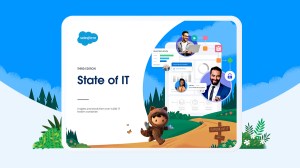91% of Organizations Believe Revenue Will Be Negatively Impacted if Digital Transformation Initiatives Aren’t Successfully Completed
SAN FRANCISCO – February 27, 2019 – MuleSoft, provider of the leading platform for building application networks, today announced the findings of the 2019 Connectivity Benchmark Report on the state of IT. Based on a global survey of IT leaders, the report reveals that while 97 percent of organizations are currently undertaking or planning to undertake digital transformation initiatives, integration challenges are hindering efforts for 84 percent of organizations. Close to half of all respondents (43 percent) reported more than 1,000 applications are being used across their business, but only 29 percent are currently integrated together, trapping valuable data in silos.
The survey of 650 respondents also reveals that IT is struggling to keep up with business demands, as 64 percent of respondents indicated they were unable to deliver all projects last year. In addition, project volumes are only expected to grow, with respondents predicting on average a 32 percent increase this year. If digital transformation initiatives aren’t successfully completed, nine out of ten organizations believe business revenue will be negatively impacted.
Among the key results of the survey:
The IT delivery gap is widening as new technologies enter the scene
The role of IT is changing from a tactical function to a business catalyst. However, the business’ growing need for IT support is reflected in the increasing number of projects IT is expected to deliver. In addition, with a growing investment in new technologies, organizations are seeing integration challenges hinder digital transformation initiatives.
- 84 percent of respondents claim integration challenges are slowing digital transformation progress. In particular, data silos created business challenges for 83 percent of respondents.
- Legacy infrastructure and systems was the most frequently reported challenge to digital transformation. Furthermore, 59 percent of IT leaders say their legacy infrastructure makes it hard to introduce new technologies like artificial intelligence (AI), big data, and the internet of things (IoT).
- The majority (69 percent) of IT’s time remains dedicated to keeping the lights on compared to innovation. Further compounding the issue, 77 percent of respondents saw a budget increase of less than 10 percent this year. In fact, nearly one third (31 percent) of these respondents reported that budgets had either remained flat or decreased.
IT’s new role as a business catalyst
IT’s expanding role is driven by a greater need for support across lines of business. As companies race to digitally transform, what was once an IT-specific need for integration has now expanded to business units across the organization.
- 92 percent of respondents say their company’s integration needs span beyond IT to encompass a wide range of business functions, including business analysts (49 percent), data scientists (42 percent), human resources (37 percent) and marketing (36 percent).
- IT and business leaders are more aligned than ever before: Respondents who identified business and IT misalignment as a major challenge dropped from 43 percent last year to 29 percent this year.
- The alignment between IT and the business goes as far as sharing key performance indicators (KPIs). Of the respondents currently undertaking or planning to undertake digital transformation initiatives, more than three quarters (77 percent) cite increased business efficiency as a goal this year, and 71 percent cite improved customer experience as a goal.
Preparing for the future one API at a time
For IT to become a business enabler, organizations are increasingly turning to API strategies to support reuse and self-service. By creating reusable assets, IT enables the business to increase overall delivery speed and capacity.
- 91 percent of respondents from organizations that own public and/or private APIs are experiencing significant business outcomes as a result, including greater productivity (53 percent), decreased operational costs (33 percent) and increased revenue growth (29 percent). For 36 percent of respondents, APIs are generating more than 25 percent of their organization’s revenue.
- Respondents who manage their APIs like products were more likely than their peers who own APIs to report increased innovation (49 percent versus 40 percent) and greater agility across teams to self serve IT (58 percent versus 46 percent).
- Respondents who always reuse software assets when developing new projects were more likely than their peers who own APIs to report increased productivity (63 percent versus 53 percent) and revenue growth (41 percent versus 29 percent).
“Today, businesses are competing on speed and agility as they race to meet customer expectations. As a result, every organization is undergoing digital transformation in order to offer a completely connected customer experience. It has put integration in the spotlight as a top-level business priority,” said Greg Schott, CEO, MuleSoft. "With the IT landscape only growing more complex, organizations can build their applications networks one API at a time, providing businesses with an agile foundation for success in the digital era.”
"As organizations across all industries digitize their business models, the ability to connect and reuse technology assets becomes a critical capability,” said Steve Stone, technology advisor and former CIO of several Fortune 500 brands including Lowe’s and L Brands. “Reusable APIs serve as building blocks in the application network, enabling new business models and simplifying the expansion of a connected partner ecosystem. MuleSoft’s Connectivity Benchmark Report demonstrates the importance of adopting a comprehensive API strategy in driving desired business outcomes."
To learn more about how IT professionals are driving digital transformation, download the complete MuleSoft 2019 Connectivity Benchmark Report.
Methodology
The survey was commissioned by MuleSoft and independently carried out by Vanson Bourne. A total of 825 IT decision makers were interviewed in December 2018 across the US, UK, Germany, Netherlands, Australia, Singapore, China, France, Japan, and Hong Kong. To allow year-on-year comparisons, all statistics in this press release exclude 175 respondents representing France, Japan and Hong Kong, who were not interviewed for last year’s report. Therefore, the statistics in this press release are derived from a base of 650 IT decision makers across the US, UK, Germany, Netherlands, Australia, Singapore, and China. The respondents were from enterprise organizations in both the public and private sector with at least 1,000 employees. Interviews were conducted online using a rigorous, multi-level screening process to ensure that only suitable candidates were given the opportunity to participate.
About Vanson Bourne
Vanson Bourne is an independent specialist in market research for the technology sector. Their reputation for robust and credible research-based analysis is founded upon rigorous research principles and their ability to seek the opinions of senior decision makers across technical and business functions, in all business sectors and all major markets. For more information, visit www.vansonbourne.com
About Anypoint Platform
MuleSoft’s Anypoint Platform™ is a leading application network platform. It allows organizations to create composite applications that connect apps, data, and devices through API-led connectivity to form a flexible application network. Anypoint Platform is a unified, single solution for iPaaS and full lifecycle API management, both on-premises and in the cloud.
About MuleSoft, a Salesforce company
MuleSoft’s mission is to help organizations change and innovate faster by making it easy to connect the world’s applications, data and devices. With its API-led approach to connectivity, MuleSoft’s market-leading Anypoint Platform™ empowers over 1,600 organizations in approximately 60 countries to build application networks. By unlocking data across the enterprise with application networks, organizations can easily deliver new revenue channels, increase operational efficiency and create differentiated customer experiences. For more information, visit https://www.mulesoft.com.
MuleSoft is a registered trademark of MuleSoft, Inc., a Salesforce company. All other marks are those of respective owners.
###
Media Contact
Matt Torres
MuleSoft
press@mulesoft.com
415-294-0161
About Salesforce
Salesforce is the #1 AI CRM, empowering companies to connect with their customers in a whole new way through the power of CRM + AI + Data + Trust on one unified platform: Einstein 1. For more information visit: www.salesforce.com.
Any unreleased services or features referenced in this or other press releases or public statements are not currently available and may not be delivered on time or at all. Customers who purchase Salesforce applications should make their purchase decisions based upon features that are currently available. Salesforce has headquarters in San Francisco, with offices in Europe and Asia, and trades on the New York Stock Exchange under the ticker symbol "CRM." For more information please visit https://www.salesforce.com, or call 1-800-NO-SOFTWARE.











